|
FAQs on the Hydrozoan Identification
5
Related Articles: Hydrozoans, Cnidarians, Fire Corals, Stylasterines, Hydrozoan Jellies,
Related FAQs: Hydrozoan ID 1, Hydrozoan ID 2, Hydrozoan ID 3, Hydrozoan ID 4, Hydrozoan ID 6, Hydrozoan ID 7, Hydrozoan ID 8, & Hydrozoans 1, Hydrozoans 2, Hydrozoan Behavior, Hydrozoan Compatibility, Hydrozoan Selection, Hydrozoan Systems, Hydrozoan Feeding, Hydrozoan Disease, Hydrozoan Reproduction,
Medusoids/Jellies (Ctenophores, some Hydrozoans,
Scyphozoans): Jelly Identification, Jelly Behavior, Jelly Compatibility, Jelly Selection, Jelly Systems, Jelly Feeding, Jelly Disease, Jelly Reproduction, Fire Corals,
Lace
Corals, Stinging-celled
Animals
|
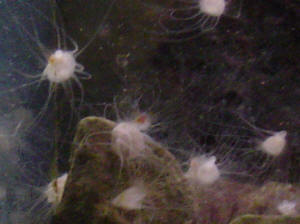
|
|
Re: Question about hermit crab growths
10/6/08 Thanks for the reply. I got a somewhat better
picture of it, still not GREAT but hopefully helps you out a
little more than the last one. Grant <Ahh, thank you for this
pic... do look "Polypoid"... am more sure these are
indeed Hydroids/Hydropolyps... There are many "kinds"
as you will see... as long as these don't spread to your
hardscape, I would count your Hermit lucky to have such a built
in defense. Cheers, BobF>
|
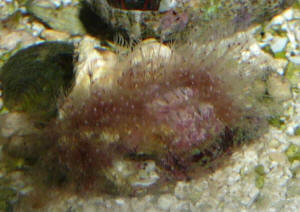 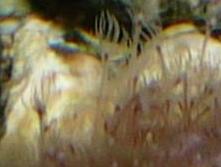 Oh yeah
Oh yeah |
|
Purple Feather Weed? Could Be Feather Hydroids!
9/13/08 Hi Guys and Gals, <Hi there, Andrew> While
snorkeling today (thank God it's warm enough to get in the
water again!) I came upon this fascinating (to me anyway)
feather-like organism. <it's neat looking, that's for
sure.> I couldn't help but lift a small piece off the rock
for an experiment in my 20Gal. <Were you wearing gloves at the
time?> Tank is currently about 2 months old, cycled with 6Kg
semi-cured live rock, and live sand. Ammonia, Nitrite @ 0, and
Nitrate is at about 10 at the moment, <Just keep an eye on the
nitrates, don't let them get above 20ppm.> temp steady at
26 Deg C, and salinity is 1.022 <Salinity's a little on
the low end, but okay.> Stocking is 1 bicolour Dottyback, 2
tiny blue/green chromis, 1 even smaller yellow coral goby, 3
small hermits, and about 8 snails. All very happy in their
current home. <Good> Which brings me to my actual
question.... What the heck is it!? <I sincerely hope I'm
wrong, but those sure look like feather hydroids to me (Family:
Plumulariidae). If so, they're not the best addition to a
system, to say the least. Also, after going in for a close-up,
that red macro-algae on the right side of the rock looks very
similar to a variety that can be invasive and very difficult to
control.> I found it in full sun at a depth of about 9'
(growing on a football sized tunicate) <Wow!> ..in a bed of
sand held together with fine hair algae. It came away in a nice
clump about 2" across. It now graces the front of a lightly
stocked tank. Each "feather" is separate from the next,
and grows just like a real bird feather would, <Yep>
looking side on, you can see a single "tap" root about
the length of the feather itself. <That long 'tap'
root along with the unusual color is what's keeping me from
being absolutely sure those are hydroids.> I'm pretty sure
in between the main subject of the pic is some juvenile Dictyota,
<It looks like a Rhodophyta/red algae of some sort, but I
can't see it well enough to narrow it down further. Dictyota
is a brown algae (Phaeophyte) that's usually green,
yellow/brown, or even blue. I've never seen red. It could be
something like Scinaia.> ..but cannot find any reference to
the feather like growth (which I find most attractive), <I
find it very attractive as well. By the way, I couldn't find
any similar looking macro-algae in that color either - and I was
hoping I would!> ..but am a little cautious of! <Good call!
Hydroids can sting the living daylights out of you. Please see
the information and species 'Gymnangium' half-way down
this link (as well as associated links at the top):
http://www.wetwebmedia.com/hydrozoans.htm Here's a good
close-up of a feather hydroid. Note the similar, almost
bumpy/broken appearance of the 'branches'. Those bumps
are actually individual feeding polyps that have little stinging
tentacles surrounding them:
http://www.poppe-images.com/images/image_info.php?picid=929540
.> If you could help identify it, I would be most
appreciative. <Well, I'm pretty sure those are hydroids,
but I'm hoping Bob will confirm or deny.> I make an effort
to Identify everything I can myself, <Good for you! Not only
do you get the satisfaction of solving a mystery, you also learn
quite a bit along the way.> ..but find it difficult to locate
images on your site unless I know the name of the organism I am
looking for. <See below> Is there an image library
somewhere grouped in broad categories like fish, algae inverts
etc. that I am yet to find on your site?? <Not a specific
image library as yet, no, but it's been discussed. In the
meantime, Bob has the site organized/sectioned off into topics
that include many terrific articles with photos of representative
species in the most commonly seen genera. Usually that will give
you enough information to help narrow things down a bit.
Here's the main page for marine topics:
http://www.wetwebmedia.com/marine/index.htm . Just pick a
subject, start with the articles for an overview (with photos)
and go from there.> I would love to help myself in future
where possible. <I'd try the above and/or use our Google
search engine:
http://www.wetwebmedia.com/WWMAdminSubWebIndex/question_page.htm
> Thanks for your time. All the best. Andrew.
<You're very welcome, Andrew. Take care, -Lynn>
|
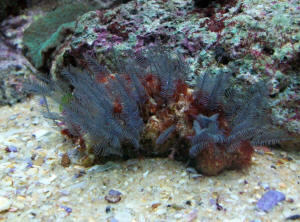 Hydroid. RMF Hydroid. RMF |
Is this Ich? - 07/13/08 Hi crew - <Hello
Joel.> Along with all of your other truly valuable services, I
am very fond of your ability to educate me by identifying various
biological life forms. <I'll give it a try.> I have a
silver-tipped pulsing xenia that has been in QT for 21 days as of
tomorrow <Very good quarantine practice.> , is pulsing quite
happily, and I plan to move to the main display tomorrow as well.
However, I don't know if these guys are tomonts or just some
white filter feeder. <The latter.> These images are all at
10x magnification, and image 2553.JPG shows what they look like
under normal viewing conditions. Any idea what they are?
<Hydromedusae, also called hydroid jellyfish. See
http://www.wetwebmedia.com/jellyidfaqs.htm.> I hope not tomonts.
<Nope. Tomonts are even smaller. They are 300-500 micrometers
and look totally different.> Thanks, Joel.
<Cheers, Marco.> |
|
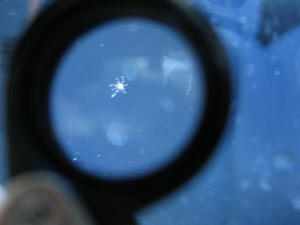 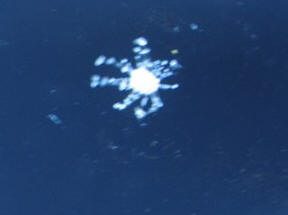
|
Sponge ID... uhh, worse 7/6/08 Hi Bob
and Crew, Can you help us identify this thing (we think it's a
form of a sponge) growing from under our Goniopora. All of our
parameters have been good, we just noticed this one night when the
Goniopora had gone in. Picture is at:
http://photo.evasionoftruth.com/g1/aquarium/IMG_0849cropped Its
directly in the center growing from under the frag disc. We are
wondering if we should remove it, it appears to be a filter feeder
as it does not retract when we touch it. <... is a Hydrozoan...
and is stinging the bejeesus out of the Poritid... needs to be
removed, scrubbed clean (with vacuuming if done underwater)
entirely. Please read here:
http://wetwebmedia.com/hyzoancompfaq.htm> Keep up the great work
on the site, we use it daily to find out things about having a reef
tank. Thanks, Buster
<Thank you for sharing Buster. Bob Fenner> |
|
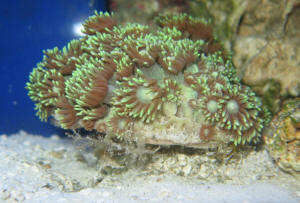 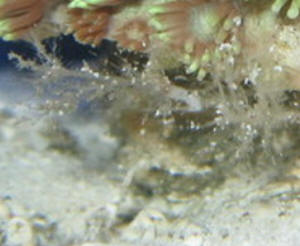
|
Help identifying 2 pics? 06/21/08 Dear wet
web media, I have searched way too many hours on these things
growing in our saltwater aquarium (120 gal). It's been
established for a couple years now, but I am noticing these things
multiplying recently. I've attached a pic of some of them. They
seem to be mostly at the bottom of the tank on the glass. Their
tentacles seem to move. <The pics are really too blurry to make
much out... but from your description below, I'd say
they're likely harmless Spirorbis worms.> In the second pic
I have many tubes of different shapes. They seem to be growing
larger. Some are long & skinny, where this one is kind of boot
shaped with an obvious hole in it. <They look like sponges to
me.> One thing I notice is white specs all over the glass at
times. If you look really close they look kind of spiral shaped. I
sort of think it looks like a snail (and I have hundreds of
different sized baby snails that just keep showing up). Cold they
be reproducing? <Could be... are these things stationary or
mobile?> Thank you for your help.
Kristie
<De nada,
Sara M.> |
|
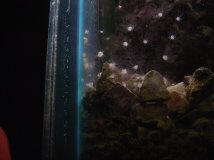 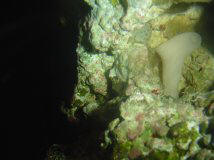
|
Re: help identifying 2 pics?
6/22/08 Just to clarify, I have two things I am trying to
identify. One is the specks that show up on the tank glass, that
develop into spirals. I'm just curious about these. Was
wondering if they were snails reproducing. <possibly...> The
one I am most concerned with is the tentacle like things that are
multiplying on the glass near the bottom of the tank. Please let me
attach one more pic that is a little more close up. Maybe you can
identify it better. These don't seem to move at all, although
the tentacles or arms (like hairs) seem to be alive & moving
(not just with a current). They worry me that I should be getting
rid of them. I probably have 20-30 of them that have developed in
the last month or two. <Ah, now I can see them... looks like
Hydroids. http://www.wetwebmedia.com/hydrozoanfaqs.htm> Thank
you for your Kristie
<Best,
Sara M.> |
|
 Ohh, Hydrozoans. B Ohh, Hydrozoans. B
|
|
Identification -- likely
Hydroids -- 05/27/08 First off, thank
you all for being so kind as to help identify a coral I have
asked about before, and now have a larger image of so you can get
a better look at the rooting/matting system of it. <Please
send earlier correspondence along when mailing follow-up
questions.> I have been told that this is anything from
Hydroids to Clove Polyps, none of which I believe it is. <Add
me to the ones saying Hydroids.> It grows really well.
<Hydroids do so, especially nasty ones.> I took the first
clump out in November, and here it is again creeping onto the
rocks. <People have left the hobby because of these
things.> It does not sting, and it doesn't suffocate
anything that I can tell... <Can possibly hurt and eventually
kill corals.> I really like it, but I don't want to harm
anything, so if someone could please help to properly ID this,
I'd greatly appreciate it. <Likely hydroids of the family
Tubulariidae, possibly even genus Tubularia (compare to internet
and literature pictures) or related. Should not touch sensitive
corals, may become a pest or simply vanish someday within a short
time. Cheers, Marco.>
|
|
 Gorgeous pic. RMF Gorgeous pic. RMF
|
|
|

